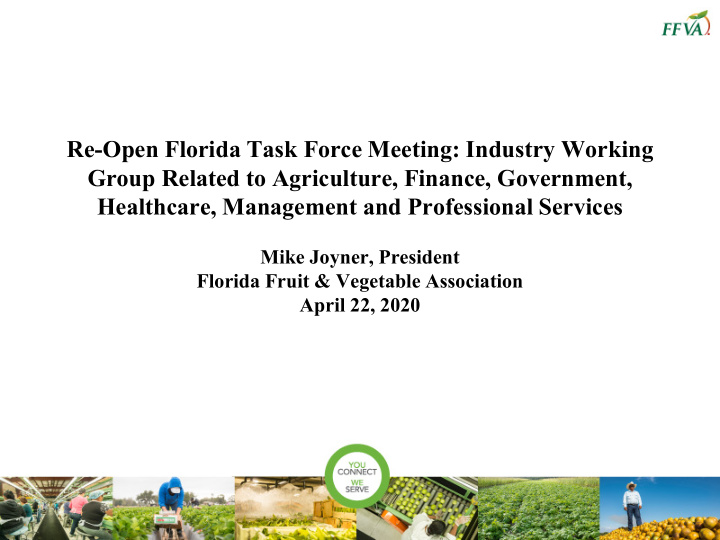



Re-Open Florida Task Force Meeting: Industry Working Group Related to Agriculture, Finance, Government, Healthcare, Management and Professional Services Mike Joyner, President Florida Fruit & Vegetable Association April 22, 2020
Issues Overview • Impact on Florida’s Agricultural Industry and Current Economic Outlook • Current Barriers within the Supply Chain • Protocols for Social Distancing in Agricultural Operations
Impact on Florida’s Agricultural Industry and Current Economic Outlook • Florida agriculture is a $160 billion a year industry. (UF/IFAS EDIS document FE1020) • Florida’s fruit and vegetable industry alone has a $8.37 billion economic impact, providing almost 62,000 jobs . (Economic Contributions of Agriculture, Natural Resources, and Food Industries in Florida in 2016, UF/IFAS) • Florida ranks No. 1 in the United States in the value of production of grapefruit, oranges, squash, sugarcane, cucumbers for processing, and fresh market tomatoes. It is No. 2 in the U.S. in the value of production for bell peppers, sweet corn, strawberries, snap beans, fresh market cucumbers and watermelons.
Impact on Florida’s Agricultural Industry and Current Economic Outlook • From late October to mid-May, South Florida vegetable growers supply fresh produce to more than 150 million people in the eastern United States from Miami to Chicago. • The shutdown of foodservice markets and the slowdown at the retail level have caused estimated crop losses in Florida through mid-April upwards of $522.5 million. Major crops affected include green beans, lettuce, cabbage, zucchini and yellow squash, peppers, cucumbers, sweet corn, watermelon, tomatoes, blueberries and radishes. • During this crisis, Florida growers have donated millions of pounds of fresh produce to food banks, church pantries, hospitals, nursing homes, first responders and other community organizations.
Impact on Florida’s Agricultural Industry and Current Economic Outlook • This pandemic is a double blow to produce growers in Florida, most of which are multigenerational family farms. They already have experienced significant losses for two decades under NAFTA from unfair trading practices by Mexico. • From 2000 to 2019, Mexican imports into the U.S. increased 551 percent. Now, this pandemic has crushed Florida specialty crop markets.
Impact on Florida’s Agricultural Industry and Current Economic Outlook • Total estimated specialty crop losses in Florida through mid-April 2020 for are upwards of $522.5 million. Examples include: – Lettuce - $5-7 million. – Green Beans - $40-50 million – Cabbage - $24 million – Peppers - $10 million – Cucumbers - $33-38 million – Sweet Corn - $48 million – Watermelon - $95 million – Tomatoes - $133 million – Radishes - $1.5 million
Current Barriers within the Supply Chain • Farm Food Service • Farm Retail • Farm Community Feeding Programs
Protocols for Social Distancing in Agricultural Operations • National Council of Agricultural Employers (NCAE) Recommendations - Revised 4.6.20 • Areas Covered – Hygiene – Employees Who Are Ill – Perform Routine Environmental Cleaning in High traffic Areas of the Operation – Training & Changes to Processes – Limit Non-Essential Visits and Travel
Questions? Mike.joyner@ffva.com
Recommend
More recommend